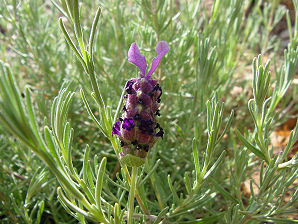Xeriscape Landscape Plants For The Arizona Desert Environment
Pictures, Photos, Reviews, And Planting Information,
Shrubs.
Spanish Lavender, Lavandula stoechas.
We Are Proud Of Our SafeSurf Rating!
Click On Any Of The Following Links By Amazon.Com
For Books, & Videos About Wildflowers Of Arizona & The Southwest USA. No Obligation!
 |
| Spanish Lavender, Lavandula stoechas, "Quatsi" |
|---|
 |  |
| Spanish Lavender, Lavandula stoechas. | Other Common Names: Rabbit Ears, Papillon, or Butterfly. |
|---|
Spanish Lavender.
We wish to thank Wikipedia, the free encyclopedia for some of the information on this page. We share images and information with Wikipedia. There are many subspecies of this plant. it is a very popular landscaping plant worldwide and it is considered an evergreen shrub. The fragrance of this species is between a true lavender scent and a pungent rosemary fragrance. From this lavender plant is extracted the French Oil; which is used for air fresheners, deodorants, disinfectants, and insecticides.
Quick Notes:
Height: Evergreen bush slowly growing to about 28 inches tall and 28 inches wide. Most from the nursary are about 8 inches to 14 inches in height.
Flowers: The squarish flower spike is composed of closely set fertile bracts which house the corollas (actual flowers) and is topped by a tuft of large, showy, sterile bracts which are the more conspicuous part of the inflorescence.
Flowering Time: Mid March - May..
Stalk: The flower stalk (peduncle) is usually shorter than the flower spike.
Leaves: The narrow, linear, stalkless, thick leaves, about 1 1/2 inches long with characteristic square teeth on the edge, coverd with a fine grey down, usually giving a grey-green overall appearance.
Found: Native of the world Mediteranian Regions. Grows wild in Spain.
Hardiness:
Soil pH requirements:
Sun Exposure:
Elevation: Can be found from 0 - 2,500 Feet.
Habitat: Chalky/alkaline, Dry, Sandy, Well-drained/light soils. An ideal landscape plant in Arizona.
Miscellaneous: Flowering Photos Taken June 6, 2005. Glendale Public Library, Xeriscape Demonstration Garden.
|
We Are Proud Of Our SafeSurf Rating!
Click On Any Of The Following Links By Amazon.Com
For Books, & Videos About Wildflowers Of Arizona & The Southwest USA. No Obligation!
| © 1966 - Present, Audrey, Eve, & George DeLange |